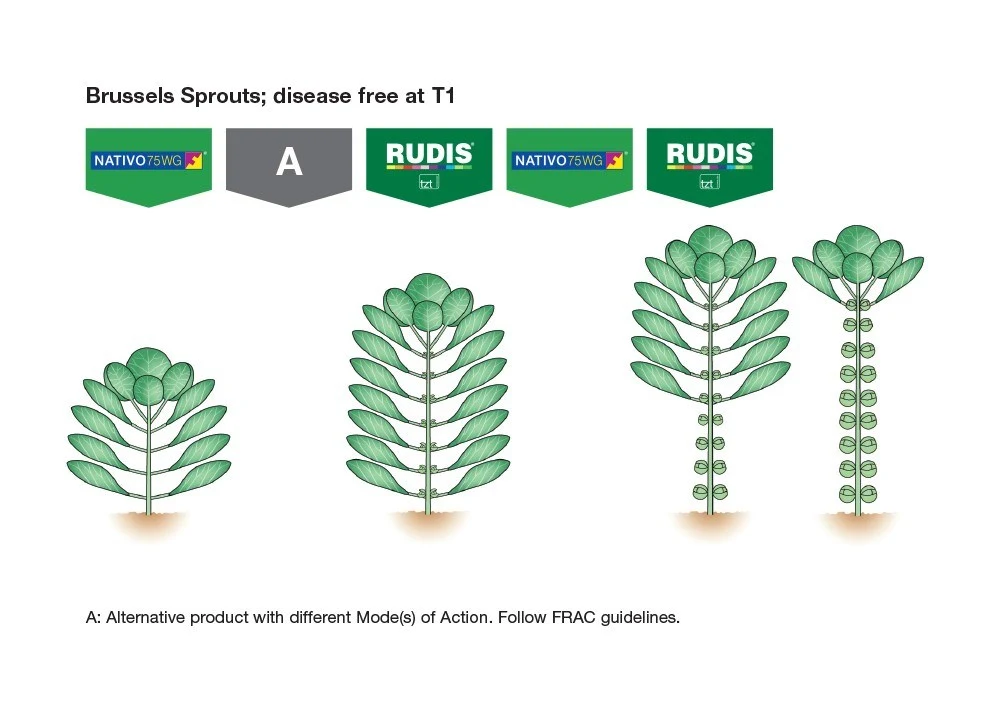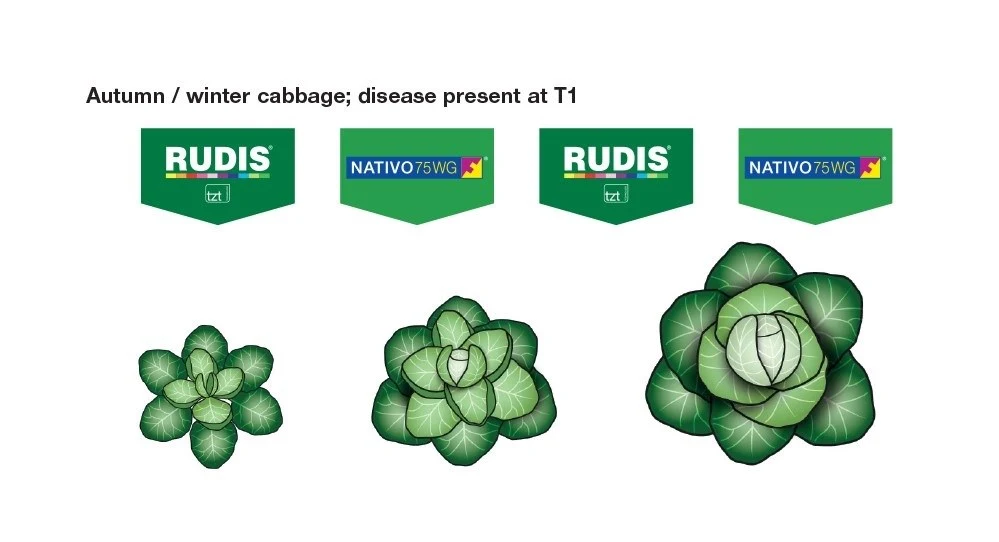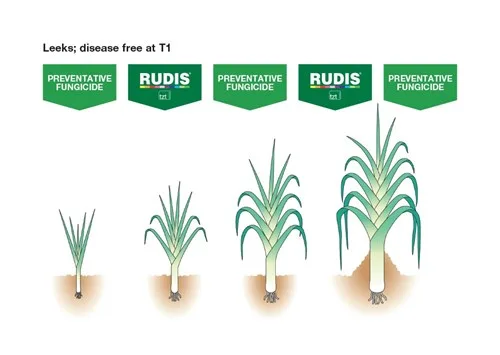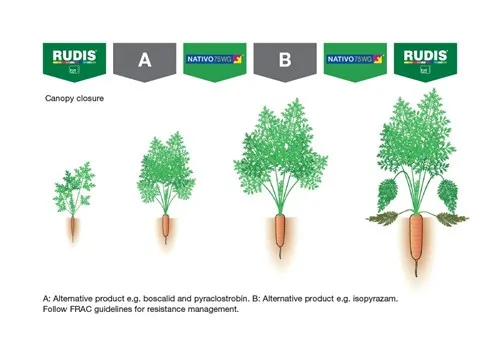

Rudis
Gain enhanced leaf and root health for greening and physiological yield effects. Rudis is specifically developed for vegetable crops.
Product details
A broad spectrum systemic fungicide with protectant and curative properties for use on cabbage, Brussels sprouts, cauliflower, broccoli/calabrese, carrot, parsnip, swede, turnip and leeks.
Product Profile
Important Information
Restrictions
Do not apply by hand-held equipment e.g. knapsack sprayer.
* Use only on carrot crops that will be mechanically harvested.
If the crop is intended for processing consult the processor before use of Rudis.
Strongest broad spectrum DMI
Best QoI alternation partner
Kinder dedicated formulation for vegetable crops
Only DMI with QoI type physiological boosting effects
The tzt technology in Rudis advances disease control and plant health. Being a new generation DMI it combines exceptional protection with sustained curative activity for powerful broad-spectrum disease control. Uniquely for a DMI it also stimulates photosynthesis and enhances nitrogen assimilation to deliver greening and physiological yield effects in the same league as strobilurins.
Brussels sprouts, cabbage, broccoli/calabrese, cauliflower
For the control of dark leaf spot (Alternaria brassicae & Alternaria brassicicola), ring spot (Mycosphaerella brassicicola) and powdery mildew (Erysiphe cruciferarum).
* Qualified minor use: Based on limited data control of light leaf spot (Pyrenopeziza brassicae) and Phoma leaf spot (Phoma lingam) in brassicas would also be expected from applications of Rudis.
The first application is recommended before disease establishes in the crop, making use of disease forecasting systems as appropriate. This should be followed by further applications at intervals of about 21 days.
For control of brassica leaf spot diseases (Alternaria species, Mycosphaerella brassicicola) or for curative activity against other target diseases, mixing with an approved sticker/wetter adjuvant may enhance the activity of Rudis.
For control of white blister mix with a specific oomycete fungicide such as Infinito (under EAMU 2015 2557).
Programme planning
Trials show the best response for boosting quality and yield comes from using Rudis in sequence with Nativo 75WG in programmes.
If the crop is disease free when the programme begins, apply Nativo 75WG first (T1) for its protectant activity and plant health promoting characteristics, then follow with Rudis and alternate the two.
If the crop has disease present when the programme begins, apply Rudis first (T1) for its curative activity and greening effect, then follow with Nativo 75WG and alternate the two.
At times it may be necessary to use a block of two sprays of Rudis or Nativo 75WG according to the situation faced.
The diagrams alongside show example programmes in Brussels sprouts and autumn/ winter cabbage.


Leeks
For the control of leek rust (Puccinia allii) and purple blotch (Alternaria porri).
* Qualified minor use: Based on limited data, useful reductions in Cladosporium allii (leaf blotch) and Stemphylium botryosum in leeks would also be expected from applications of Rudis.
The first application is recommended before disease establishes in the crop (making use of disease forecasting systems as appropriate). This should be followed by further applications at intervals of about 21 days.
For control of leek rust, mixing with an approved sticker/wetter adjuvant may enhance the activity of Rudis if in a curative situation or if the crop is very waxy.
For control of white tip mix with a specific oomycete fungicide such as Infinito (under EAMU 2016 1552).
Programme planning
If the crop is disease free when the programme begins, apply a preventative fungicide first, and then follow with Rudis as illustrated below.
If the crop has disease present when the programme begins, apply Rudis first for its curative activity and greening effect, then follow with another alternative chemistry and alternate the two.
At times it may be necessary to use a block of two sprays of Rudis according to the situation faced.

Carrots
For the control of leaf blight (Alternatia dauci) and powdery mildew (Erysiphe heraclei) and for moderate control of Sclerotinia rot (Sclerotinia sclerotiorum).
The first application is recommended before disease establishes itself in the crop (making use of disease forecasting systems as appropriate). This should be followed by further applications at intervals of about 21 days.
Typically the first application should be made prior to canopy closure in June/July; this is particularly important for control of Sclerotinia sclerotiorum to ensure that all leaves are adequately protected as the microclimate under the crop becomes optimal for ascospore release from soil germinating apothecia.
To reduce Alternaria infection on the leaves Rudis should be applied in early/mid August, or when first signs of disease appear on the foliage after the 5 true leaf stage of the crop (GS 15) if earlier than early/mid August.
Programme planning
Trials show the best response for boosting quality and yield comes from using Rudis in sequence with Nativo 75WG in programmes.
If the crop is disease free when the programme begins, apply Nativo 75WG first for its protectant activity and plant health promoting characteristics, then follow with Rudis and alternate the two as illustrated alongside.
If the crop has disease present when the programme begins, apply Rudis first for its curative activity and greening effect, then follow with Nativo 75WG and alternate the two.
At times it may be necessary to use a block of two sprays of Rudis or Nativo 75WG according to the situation faced.

Parsnip, swede and turnip
* Qualified minor use: Based on limited data Rudis will control leaf blight (Alternaria dauci) and powdery mildew (Erysiphe heraclei) and provide moderate control of Sclerotinia rot (Sclerotinia sclerotiorum) in parsnip and powdery mildew (Erysiphe cruciferarum) and Alternaria (Alternaria brassicae) in swedes and turnips.
The first application is recommended before disease establishes itself in the crop (making use of disease forecasting systems as appropriate). This should be followed by further applications at intervals of about 21 days.
Typically the first application should be made prior to canopy closure in June/July; this is particularly important for control of Sclerotinia sclerotiorum to ensure that all leaves are adequately protected as the microclimate under the crop becomes optimal for ascospore release from soil germinating apothecia.
To reduce Alternaria infection on the leaves Rudis should be applied in early/mid August, or when first signs of disease appear on the foliage after the 5 true leaf stage of the crop (GS 15) if earlier than early/ mid August.
For control of leaf spot diseases (Alternaria species) on swede and turnip or for curative activity against other target diseases on these crops, mixing with an approved sticker/wetter adjuvant may enhance the activity of Rudis.
* Minor use qualification
There is limited evidence of crop safety and/or product efficacy available for qualified minor uses and the commercial risk of using this product under this/these Qualified Minor Use(s) is borne entirely by the grower.
Rudis contains prothioconazole, a member of the DMI cross-resistance group. Use Rudis as part of an Integrated Crop Management (ICM) strategy incorporating other methods of control, including where appropriate other fungicides with a different mode of action.
The possible development of disease strains resistant to Rudis cannot be excluded or predicted. Where such resistant strains occur, Rudis is unlikely to give satisfactory control.